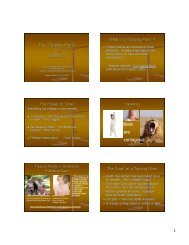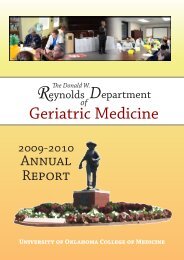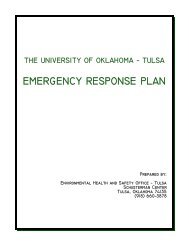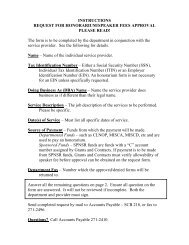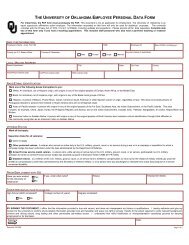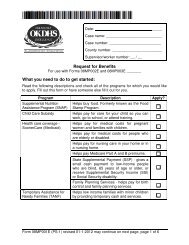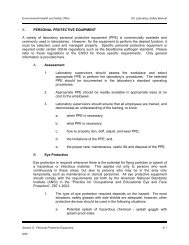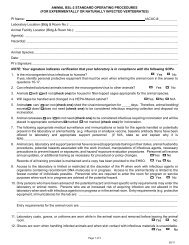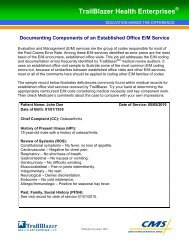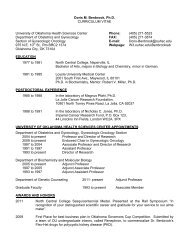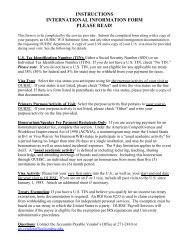The Unofficial Guide to First Year - University of Oklahoma Health ...
The Unofficial Guide to First Year - University of Oklahoma Health ...
The Unofficial Guide to First Year - University of Oklahoma Health ...
Create successful ePaper yourself
Turn your PDF publications into a flip-book with our unique Google optimized e-Paper software.
UNOFFICIAL GUIDE<br />
essential for success in the lab portion <strong>of</strong> this course…I cannot stress this enough!<br />
<strong>The</strong> original author advises steering clear <strong>of</strong> the question bank questions except<br />
for Dr. Foreman’s. <strong>The</strong>se are a little bit shaky and may cover <strong>to</strong>pics not really<br />
discussed or just have <strong>to</strong>tally incorrect answers, but I don’t think it hurts <strong>to</strong> do<br />
them unless it just confuses you <strong>to</strong>o much. In addition, definitely don’t forget<br />
the practice tests and questions posted on Blackboard, as these are truly<br />
invaluable. Also, take advantage <strong>of</strong> your note groups and MP3 recordings; these<br />
are just an additional <strong>to</strong>ol that is far <strong>to</strong>o <strong>of</strong>ten underused.<br />
BOOKS: I personally was not a book man and did just fine (learn <strong>to</strong> love your<br />
syllabus), but here are the thoughts <strong>of</strong> other students on the numerous titles out<br />
there.<br />
This class is a conglomeration <strong>of</strong> many different areas relating <strong>to</strong> the nervous<br />
system so one source will not cut it. You will find that with the right<br />
complement <strong>of</strong> books you can find a text <strong>to</strong> treat ALMOST every section <strong>of</strong> the<br />
course (except Ross – he is in a world <strong>of</strong> his own). Here is a summary <strong>of</strong> the<br />
major books:<br />
• Bear et al, Neuroscience: Exploring the Brain. Written in incredible<br />
simplicity, yet detailed and comprehensive, this book will break it down,<br />
get jiggy with it, and then tell you what you already forgot. It’s expensive.<br />
Some used it only occasionally, since the syllabus is so comprehensive in<br />
this course. If you want the above and beyond, or a second reliable and<br />
easy <strong>to</strong> read reference, YOU + Exploring the Brain = Two thumbs up.<br />
• Haines, Fundamentals <strong>of</strong> Neuroscience – this is a good all around textbook<br />
and is the one recommended by the class before us. It particularly treats<br />
the sections on medulla, pons, and midbrain well. If confused, it should<br />
be your first resort.<br />
• Young & Young, Basic Clinical Neuroana<strong>to</strong>my – this is a good book for the<br />
clinical parts <strong>of</strong> the course as it covers agnosias, aphasias and deficits well.<br />
It has a great section on lesion localization cases.<br />
• Fix, BRS: Neuroana<strong>to</strong>my – this book is a good review before tests and it<br />
has good chapters on the audi<strong>to</strong>ry and visual systems as well as the spinal<br />
cord and neurohis<strong>to</strong>logy.<br />
• Kiernan, Barr’s <strong>The</strong> Human Nervous System – not widely used but some<br />
students found this helpful for clarification in areas.<br />
ATLAS: This next part is very important…<br />
• Haines, An Atlas <strong>of</strong> Structures, Sections, and Systems –Dr. Blair recommends<br />
it and it is great. Make it your best friend.<br />
• <strong>The</strong> Brain Atlas – this atlas is fine for some people but it lacks the diagram<br />
quality <strong>of</strong> the Haines atlas<br />
83



